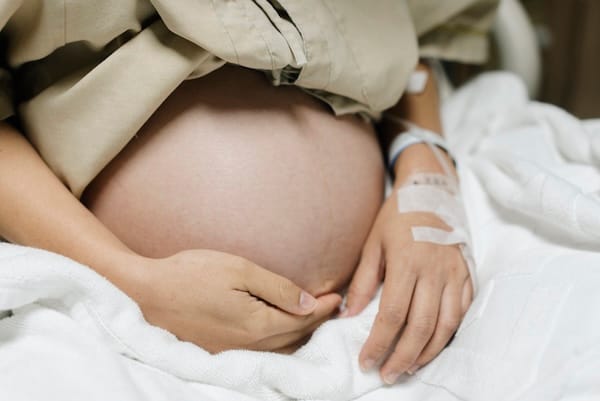[6 MIN READ]
In this article:
- Recovery after a C-section typically takes six to eight weeks and involves gradual healing, rest and self-care.
- Pain management, incision care and light movement are all important parts of the healing process.
- Emotional health matters, too. Be aware of the “baby blues” and signs of postpartum depression, and don’t hesitate to ask for support.
C-section recovery: What’s normal and what’s not
No matter how you deliver, bringing a baby into the world is a big deal. But if you deliver via C-section, your body needs extra time, care and patience to heal.
Whether your C-section was planned or unplanned, you’re now recovering from major surgery while caring for a newborn — not to mention while also dealing with typical postpartum issues like bleeding and tender breasts.
From managing pain to caring for your incision site and recognizing signs of complications, knowing what’s normal (and what’s not) can help you feel more confident and supported in your recovery.
Providence OB-GYN Dafna Trites, D.O., outlines what to expect in the days, weeks and months after a C-section — and how to care for both your physical and emotional well-being.
What’s normal during C-section recovery
Taking care of yourself after a C-section isn’t something to put on the back burner. You need plenty of rest to ensure your body heals properly — especially the first few days. In addition to feeling sore, you can also expect to feel groggy and tired, especially right after childbirth.
A general hospital timeline
After you have a C-section, you’ll likely stay in the hospital for a few days before going home. You need that time to recover from surgery and childbirth. Still, you won’t just lie in your hospital bed all day long. In most cases, you can start taking steps right away to help your recovery and start caring for your newborn.
For example, you can typically hold your baby right away after a C-section and even start breastfeeding. Also, while it may take a few hours, you should be able to eat a light meal the day of surgery and return to a regular diet the following day.
Within 12 hours, and with the help of your nurse, you can usually get out of bed and walk around a little. Your nurse will probably give you stool softeners, too, to make having a postoperative bowel movement a little easier.
By the day after your C-section, you’ll still have soreness and pain as the effects of anesthesia wear off. You’ll receive pain medication to help, though. Once your IV is removed, you’ll start oral pain relievers, like ibuprofen and acetaminophen (Tylenol®). Most pain-relief medicines are safe to take if you’re breastfeeding, but ask your doctor if you have any questions.
In addition to soreness, you’ll likely experience postpartum cramping, called afterpains, that are especially painful during breastfeeding. These pains are the result of the uterus shrinking back to its original size. You’ll still have some vaginal bleeding, but that’s normal and will likely stick around for a few weeks.
You can also take a shower. Just be careful around your incision site and listen to your nurse’s instructions for how to care for the area.
A few days after a cesarean delivery, you can likely lift your baby. The number of days may vary a little based on your pain level, but in most cases, it is fine for you to hold your baby once you feel comfortable.
By this point, your pain should also start to lessen, although the incision will remain tender for a few weeks. “You may also experience some numbness around the incision,” Dr. Trites says, “but it usually resolves over a few weeks to months.”
In addition, you may be able to go home. But don’t be concerned if your nurse tells you that you need to stay for another night or two.
Once you’re home after a C-section
A week after your C-section, your stitches are likely starting to dissolve (though it takes 6-8 weeks for them to fully dissolve inside the body).
You’re probably finished with pain medicine and able to focus more fully on taking care of your baby.
Two weeks after your C-section, your doctor may approve you to start light exercise like walking or yoga. You can also likely drive.
While you may start feeling better after a week or two, remember that it generally takes six to eight weeks to fully heal after a cesarean birth. That’s why it’s important to follow your doctor’s instructions for when you can resume activities like strenuous exercise.
Mobility and movement
Taking short walks after a C-section — once your doctor gives you the go-ahead — promotes healing and circulation, and reduces the risk of potential complications, like constipation and blood clots. Just start slowly and increase your movement gradually.
To regain strength and flexibility, you can also try a deep breathing practice, light yoga poses and pelvic floor exercises.
Caring for your incision site
Once you’re home, you still need to prioritize incision site care. Your doctor will send instructions home specific to how you should care for your incision, but in general, you should avoid baths and swimming until your doctor approves them. If you notice pus, swelling or redness at your incision site, call your doctor. It could signal an infection. Other infection signs include a fever or chills.
A heating pad may also help relieve discomfort and soreness around the incision site.
In addition, if you’re breastfeeding, choose a position, like the football hold or side-lying hold, that doesn’t apply pressure to your incision. You can use a firm pillow to help protect your incision site.
Pain relief
Pain relief after a C-section is paramount. Your doctor will likely prescribe more pain medicine and a stool softener before you leave the hospital. You can also take over-the-counter pain medications, like ibuprofen and Tylenol, once your doctor gives you the green light.
Also, if you’re having gas pains, you can try a gas relief medication like simethicone, which helps gas pass through the digestive tract.
Other tips for healing after a C-section
Here are a few other reminders when you’re recovering from a C-section:
Eat healthy and stay hydrated
Eating high-fiber foods and drinking plenty of water can help prevent constipation. Also, choosing foods with essential nutrients your body needs for recovery can promote healing and help boost energy levels.
Rest often
Even though you may feel better a few days after your C-section, remember to rest when you can.
Ask for help
Asking for (and accepting) help after a C-section isn’t just recommended, it’s vital to the recovery process. If your family or friends offer to help with daily tasks like laundry or cooking, let them.
When to call your doctor
While pain and bleeding are most often normal after a C-section, there are occasions when they’re not. For example, if you have pain that gets worse instead of better or heavy vaginal bleeding after you leave the hospital, you should call your doctor right away. Also, if you have a fever or signs of infection at the incision site, your doctor needs to know.
Other signs of potential complications after a C-section include:
- Foul-smelling vaginal discharge
- Nausea and vomiting
- Severe abdominal pain
- Shortness of breath
- Signs of blood clots, including pain, redness or swelling in one leg
Mental health matters, too
With all that’s going on with your body after a C-section — not to mention with your new baby — you may find yourself ignoring how you’re feeling about everything, especially if your C-section wasn’t part of your birth plan.
Yet your mental health after giving birth is just as important as your physical health. And remember that everything you went through physically is naturally going to affect your mental well-being, too.
Baby blues
The so-called “baby blues” are a common experience for parents after childbirth. March of Dimes has found that the condition affects up to 80% of people, in fact.
Believed to be caused by hormone fluctuations after birth, the baby blues, or postpartum blues, are characterized by symptoms like mood swings, anxiety and crying spells. Luckily, these symptoms don’t usually last long. Typically, they go away on their own after two weeks.
Postpartum depression
If your symptoms or feelings of sadness last longer than two weeks, you need to tell your doctor, Dr. Trites says.
“That could indicate postpartum depression,” Dr. Trites says, “which is a more serious condition that requires treatment.”
Postpartum depression affects 1 in 7 women in the United States. Its symptoms mimic those of the baby blues, but they’re usually stronger and don’t go away on their own.
Get support
Finding support after childbirth can help you feel less alone. You can check local resources, like libraries, community centers and churches, for classes and support groups.
Providence also offers postpartum care and classes for new parents.
Recovery isn’t linear
Remember that recovery is usually a winding path, not a straight road.
“While you have a general overview of what to expect post-C-section, that doesn’t mean it will be the case for you,” Dr. Trites explains. “Healing from a C-section is an individual experience.”
Be gentle with yourself, and don’t hesitate to reach out for help.
Contributing caregiver

Dafna Trites, D.O., is a Providence OB-GYN at Facey Medical Group in Tarzana, California.
Find a doctor
If you’re pregnant or planning to become pregnant and are looking for an experienced, caring provider to help you navigate pregnancy and welcome your baby into the world, we can help. Providence offers maternity, prenatal care and obstetrics services.
Schedule an appointment with a Providence OB-GYN or midwife to get started.
Download the Providence app
It’s all in the app: easily stay connected with Providence and your health. With the Providence app, you can schedule appointments, have virtual visits from the comfort of your home, get health recommendations personalized for you, access your health records and so much more. Learn more and download the app.
Related resources
What you need to know: All the feelings during the postpartum period
Providence OB-GYN offers advice for a healthy pregnancy
Birth plans: What you can and can't control
What to expect after a C-section
This information is not intended as a substitute for professional medical care. Always follow your health care professional’s instructions.
About the Author
More Content by Providence Maternity Team




















